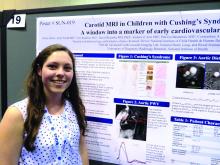ORLANDO – Cushing’s disease may begin to exert its harmful cardiovascular effects quite early, a small pediatric study has found.
Children as young as 6 years old with the disorder already may show signs of cardiovascular remodeling, with stiffer aortas and higher aortic pulse-wave velocity than do age-matched controls, Hailey Blain and Maya Lodish, MD, said at the annual meeting of the Endocrine Society.
“The study, which included 10 patients, is small, but we continue to add new patients,” said Dr. Lodish, director of the pediatric endocrinology fellowship program at the Eunice Kennedy Shriver National Institute of Child Health and Human Development. Ten more children are being added to the cohort now, and she and Ms. Blain, a former research fellow at NIH, intend to grow the group and follow patients longitudinally.Cushing’s diseases has long been linked with increased cardiovascular risk in adults, but the study by Dr. Lodish and Ms. Blain is one of the first to examine the link in children. Their findings suggest that early cardiovascular risk factor management should be a routine part of these patients’ care, Dr. Lodish said in an interview.
“It’s very important to make sure that there is recognition of the cardiovascular risk factors that go along with this disease. Elevated levels of cholesterol, hypertension, and other risk factors that are in these individuals should be ameliorated as soon as possible from an early age and, most importantly, physicians should be diagnosing and treating children early, once they are identified as having Cushing’s disease. And, given that we are not sure whether these changes are reversible, we need to make sure these children are followed very closely.”
Indeed, Dr. Lodish has reason to believe that the changes may be long lasting or even permanent.
“We are looking at these children longitudinally and have 3-year data on some patients already. We want to see if they return to normal pulse wave velocity after surgical cure, or whether this is permanent remodeling. There is an implication already that it may be in a subset of individuals,” she said, citing her own 2009 study on hypertension in pediatric Cushing’s patients. “We looked at blood pressure at presentation, after surgical cure, and 1 year later. A significant portion of the kids still had hypertension at 1 year. This leads us to wonder if they will continue to be at risk for cardiovascular morbidity as adults.”
Ms. Blaine, an undergraduate at Bowdoin College, Brunswick, Maine, worked on the study during a summer internship with Dr. Lodish and presented its results in a poster forum during meeting. She examined two indicators of cardiovascular remodeling – aortic pulse wave velocity and aortic distensibility – in 10 patients who were a mean of 13 years old. All of the children came to NIH for diagnosis and treatment of Cushing’s; as part of that, all underwent a cardiac MRI.The patients had a mean 2.5-year history of Cushing’s disease Their mean midnight cortisol level was 18.8 mcg/dL and mean plasma adrenocorticotropic hormone level, 77.3 pg/mL. Five patients were taking antihypertensive medications. Low- and high-density lipoprotein levels were acceptable in all patients.
The cardiovascular measures were compared to an age-matched historical control group. In this comparison, patients had significantly higher pulse wave velocity compared with controls (mean 4 vs. 3.4 m/s). Pulse wave velocity positively correlated with both midnight plasma cortisol and 24-hour urinary free cortisol collections. In the three patients with long-term follow-up after surgical cure of Cushing’s, the pulse wave velocity did not improve, either at 6 months or 1 year after surgery. This finding echoes those of Dr. Lodish’s 2009 paper, suggesting that once cardiovascular remodeling sets in, the changes may be long lasting.
“The link between Cushing’s and cardiovascular remodeling is related to the other things that go along with the disease,” Dr. Lodish said. “The hypertension, the adiposity, and the high cholesterol all may contribute to arterial rigidity. It’s also thought to be due to an increase in connective tissue. The bioelastic function of the aorta may be affected by having Cushing’s.”
That connection also suggests that certain antihypertensives may be more beneficial to patients with Cushing’s disease, she added. “It might have an implication in what blood pressure drug you use. Angiotensin-converting enzyme inhibitors increase vascular distensibility and inhibit collagen formation and fibrosis. It is a pilot study and needs longitudinal follow up and additional patient accrual, however, finding signs of cardiovascular remodeling in young children with Cushing’s is intriguing and deserves further study.”
Neither Ms. Blain nor Dr. Lodish had any financial disclosures.



